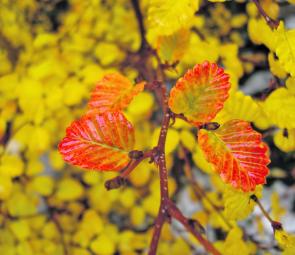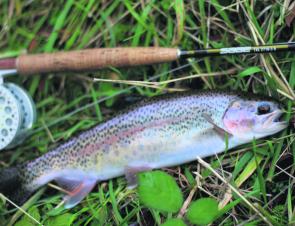Contrary to belief, the spectacular phenomenon we know as the rainbow holds no physical state.
As in, it is not an actual object but merely an optical illusion caused by water droplets reflected by the sun. Why then, do you often hear cranky fishing folk saying that they are heading out to chase rainbows? What purpose does this serve but to drive one mental if the previous statement is true?
Well, the answer lies at the end of the rainbow, and you may not know it but the so-called pot of gold does indeed exist – It’s just that those who encounter it wish to remain anonymous or keep the details to themselves. Just between you and me I’ve crossed paths with the pot of gold and although I’m risking vilification, I’m here to spill the beans.
Members of the seemingly secret society say that your best chance to encounter it is to head to Tasmania where healthy, colourful rainbows abound in masses of water droplets and with some careful planning, a few maps and a rainbow-chasing kit, you could be the lucky one to strike gold.
You may already know that Tasmania has an excellent wild brown trout fishery, known throughout the world. What you may not realise is that Tassie comprises of some special waters that hold wild, self-sustaining rainbow trout. Rainbow trout do not typically compete well in waters alongside brown trout and they are therefore less common.
Nevertheless, nerdy lab-types are often baffled as to why Tassie has scattered waters, or sections of waters where the tables are turned and rainbows dominate or thrive. While not quite as diverse as the colours of a rainbow you see in the sky, rainbow trout range from silver and chrome to having deep pink, red or purple colourations. Some even appear to have blue running through their flanks and green backs.
Now just to clarify something, trout are not native to Tasmania – rainbows were introduced in 1898, browns in 1864. Regardless, waters that have sustained populations ever since initial stockings are considered by most to be wild.
Tasmania has a small number of designated rainbow trout waters and due to different spawning times than brown trout, their open seasons differ. This year the rainbow season closes on 3rd June so there are still some great opportunities to experience them. Following are a few classics.
There are three main lakes in the Walls of Jerusalem National Park that are managed as wild rainbow waters; lakes Youd, Junction and Meston. Here amongst the pure wilderness, you would be quite content simply being surrounded by ancient pencil pines, myrtles and deciduous beech but given that you can also catch superb fish - a more picturesque fishing destination is pretty hard to find!
So the story goes, a pilot more than 60 years ago was supposed to drop a bag of rainbow trout into Lake Adelaide during miserable conditions. Anglers embarked on many fruitless expeditions to this lake and it wasn’t until someone decided to check Lake Meston over the hill that they found the place teeming with plump rainbows that had adapted quite well to the native galaxia population.
Today, this and the headwaters of the Mersey River system continue to captivate audacious anglers from all walks of life. The gut-wrenching five-hour-plus walk in may deter some enthusiasts but it’s certainly something that every angler should consider often, especially in late April and into May when the golden hues and rich red leaves of the deciduous beech light up the mountain side and are perfectly matched to the rosy-red cheeks of a wild rainbow. Flyfishing is best here from the northern shore and from a float boat, but as most shores a thick with scrub; lure fishing is generally a much simpler task.
Lake Skinner is situated in the Mt Field National Park in the states south. Much like Meston, it is a deep alpine clear water and abounds with ridiculous amounts of small to medium sized rainbows. Much of the shore can be difficult to navigate so carting in a small inflatable raft would be ideal. This will open up areas of the lake that would typically be out of reach, and often the trout cruise deeper drop-offs or mop up beetles in wind lanes further off shore.
If there is no insect activity on the surface for flyfishing, lure fishing deeper sections is a very reliable and productive fallback. Once again as a bonus, the lake is surrounded by pure wilderness, views are amazing and it’s amusing to also note that once again, the walk is a bit of a gut-buster!
Many fly fishers have a real bone to pick with Dee Lagoon, mainly due to its frustrating midge and caenid hatches! Nut them out and you are in for a real treat. Dee Lagoon is surrounded by tall gum trees which provide amazing falls of gum beetles during summer and later in the season, every few years if you’re lucky, a jassid fall may be on.
These little leafhoppers attract just as many anglers as rainbow trout and both find them very tasty and hard to ignore. Wayward jassid and gum beetles get blown onto the water and sometimes a gentle breeze will congregate them into a slick known as a wind lane. Rainbow trout cruise the wind lanes gorging themselves on the free feast. These fish can move very quickly and rarely stay in a straight line so your cast needs to be well ahead of your target fish.
‘The Dee’ as it also known also has its renowned midge hatches and the morning after a very cool, still night there will be millions of them of the water. Despite the fact that their snouts are constantly popping out of the water, getting your fly noticed amongst so many naturals is such a challenge – But that’s what we love about it (don’t we?). There are stacks of fly options but tiny, sparsely tied flies will work best for midge hatches.
This is a flooded section of the Mersey River dammed for hydro purposes. It’s eerie looking water with lots of drowned timber protruding through the lakes surface. Many anglers navigate through the trees on the electric motor searching for well-conditioned sippers or fishing deeper to fish holding tight against the structure. Others not seeking a cast and retrieve option choose to trolling along the old riverbed.
Rowallan has some deep drop offs and polarioiding from the shore for cruising can be ideal. The lake is prone to hefty drawdowns in water supply but even at its lowest there is still ample scope for fishing. The fish often have a greenish tinge to their backs and spotting them in the slightly tannin stained water is actually a lot easier than you initially may think. The handy aspect here is that you can pretty much drive to the lakeshore.
Considering the amount of rivers, creeks and streams in Tasmania you would think that there would be more than a handful where rainbows dominate. Those that are classified as rainbow (therefore open until June 3) are; Mersey River above Rowallan, Leven River above Loongana and both Weld rivers. All have their own unique appeal but the one thing they have in common is fast water sections.
Rainbows love fast water and are right at home sitting in a section so turbulent that many of us would typically ignore. Buoyant dry flies in shallow sections will attract savage takes but tungsten nymphs are often required for fast, deep water. Rainbows give an amazing account of themselves in tight quarters and deep dark holes can produce some real surprises.
There is no doubt that some natural recruitment does occur in other rivers but this can be hard to distinguish when populations are sometimes bolstered by fish farm escapees or supplemented with releases from Inland Fisheries.
Wild rainbows really are something special in Tassie; they reside in some wonderful locations, they are line-tearing speedsters that jump during the battle and will seriously challenge your casting skills. Although there have been numerous unofficial monsters weighed over the years, the largest pot of gold to be counted as an Australian record was caught in the Tasmania’s Ouse River in 1933 and weighed just under 8kg. The next one is waiting for you - somewhere over the rainbow.
Reads: 6073
The author shows off a spanking late season rainbow trout – this is what we are talking about!

Windlanes and slicks are the stuff or autumn dreams – this is the best place to find a feeding rainbow trout.

Lake Meston is an autumn trout fishers bonanza – gut busting walk in, but well worth the effort.

The pot of gold at the start of the rainbow – fagus in full flight.

The hut at Lake Meston – take some warm gear.

A golden handful – small rainbow trout from a Tasmanian stream.

There are several small streams open in May – finding them is half the fun.




